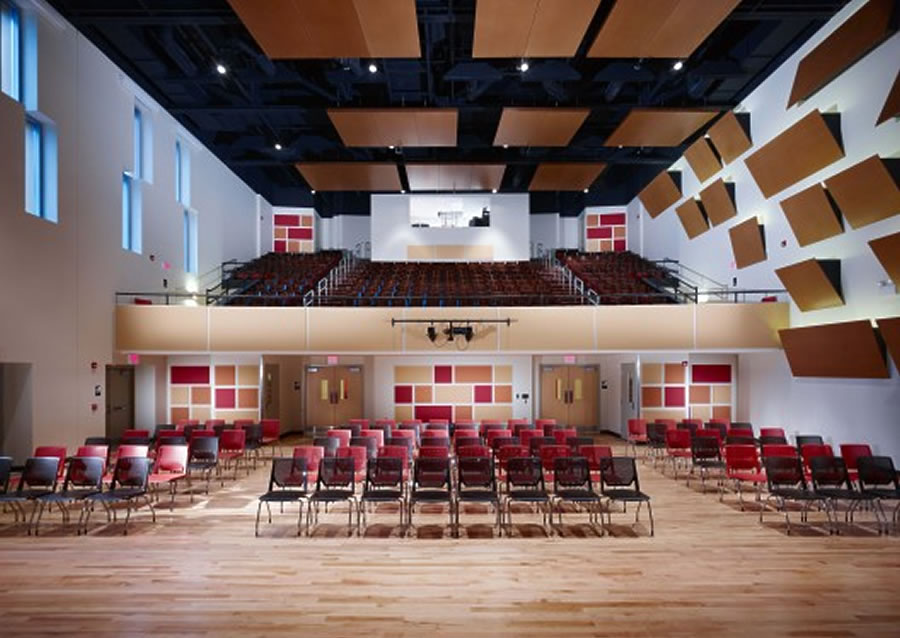American Hardwoods Offer a Breath of Fresh Air
Flooring, cabinetry, and millwork made from American hardwoods are as much a part of the American dream as a white picket fence. The beauty, architectural detail, and overall inviting warmth they offer are often what make a house a home. So, it’s no surprise that hardwoods are increasingly bringing the comforts of home to all types of settings, from schools and workspaces to healthcare facilities and performance venues. But, there is more. The American Hardwood Information Center wants you to know that hardwoods also help improve the air quality in the places you spend your time.
We’ve all seen those tiny particles floating around in a beam of sunlight. Those culprits are often the cause of many indoor allergies which affect nearly 40 million Americans. Did you know that to ease allergy symptoms, one of the first recommendations allergists make is to remove wall-to-wall carpeting in favor of solid floor surfaces, such as hardwoods?
Hardwood products offer help!
“Allergists recognize that carpet is a huge collection net for dust and dust mites, live and dead insects and their waste products, mold, and animal dander,” says Dr. Dana V. Wallace, immediate past president of the American College of Allergy, Asthma & Immunology (ACAAI). “Chemical treatments and professional steam cleaning will not remove all allergens, and are only effective for a short time. But all of these allergens can be reduced with hardwood flooring.”
The Asthma and Allergy Foundation of America (AAFA), agrees. “We recommend hardwood floors,” says spokesperson Angel Waldron. “They are easier to clean and do not harbor dust, dirt, and allergens like carpeting.” And to ease the suffering to a greater degree, Dr. Wallace suggests additional home considerations.
“The newest research shows that making one change in the home, like carpet removal, will reduce the allergen load, but it takes multiple interventions to reduce symptoms. Other changes, like removing upholstered furniture, need to be made.” And hardwood furniture, such as stools and desk chairs, offer a perfect solution.
But allergy issues exist well outside of the home. The AAFA tells us that allergies and asthma cause 40,000 people to miss school or work every day, resulting in $3 billion in lost productivity each year.
Dr. Wallace concludes that, “Perhaps the increase in allergies and asthma over the past century has some relationship to moving away from hardwood flooring. My school had hardwood flooring in the 1960’s,” she says, “and more recently, schools have been installing more carpeting. We need hard surfaces such as hardwood flooring, in public areas, to reduce allergen exposure.”

Photo © 2011 Ed Massery & Renaissances 3 Architects
Utkarsh Ghildyal, project manager at Renaissance 3 Architects understands completely, and he also feels that healthy and environmentally favorable hardwood floors are “more comfortable than concrete and are more easily maintained than carpet.” Ghildyal goes on to say that, “we use hardwoods in our designs to express warmth and a sustainable aesthetic. There is a natural feeling to hardwood that is difficult to replicate.”
The experts at Renaissance 3 Architects are not alone in their thinking. More and more designers are recognizing the limitless benefits of hardwood products, and are increasingly featuring them in schools, workspaces and healthcare facilities across the country.
But what about the finishes – won’t they affect allergies?
The American Hardwood Information Center suggests you breathe deep, relax, but be knowledgeable. Reading product labels, specifically looking for the key words “volatile organic compounds,” or VOCs, is important because VOCs are emitted by many, many items, including carpeting, electronics, cosmetics, plastics, cleaning supplies, tobacco products and more, so be aware.
Today, most paints and stains will have low- or no-VOC on their labels, and that’s significant because low- or no-VOC finishes which are water-based, are healthier for you and the environment, give off virtually no odor, and are much less likely to trigger allergies or other sensitivities.
So let’s clear the air!
The benefits of using products made from American hardwoods are limitless. Incorporate them into the places where you live, work and play. And then, breathe deep!



